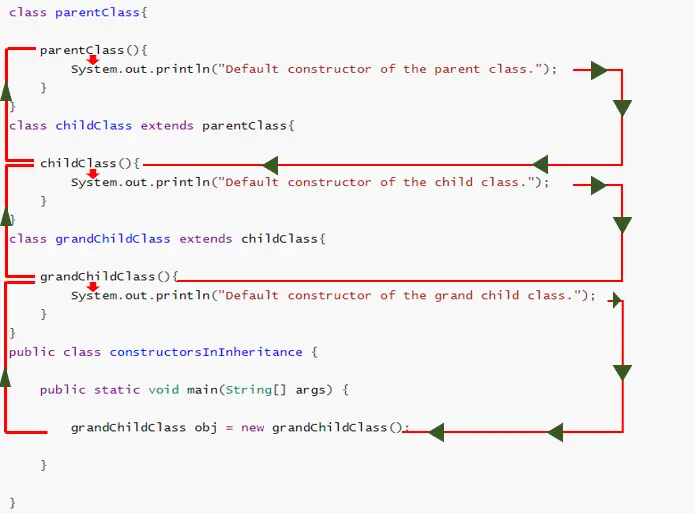在繼承中執行 Java 建構函式

今天,我們將學習繼承中 Java 建構函式的執行。我們將在派生類(也稱為子類和子類)中看到預設建構函式和引數化建構函式的程式碼示例。
在繼承中執行 Java 建構函式
繼續這篇文章需要足夠的繼承知識。如果你正在閱讀本教程,我們假設你對 Java 繼承有深入的瞭解。
讓我們在使用 extends 關鍵字擴充套件父類(也稱為基類或超類)時瞭解 Java 建構函式的執行過程。
在繼承中執行預設 Java 建構函式
示例程式碼:
class parentClass {
parentClass() {
System.out.println("Default constructor of the parent class.");
}
}
class childClass extends parentClass {
childClass() {
System.out.println("Default constructor of the child class.");
}
}
class grandChildClass extends childClass {
grandChildClass() {
System.out.println("Default constructor of the grand child class.");
}
}
public class constructorsInInheritance {
public static void main(String[] args) {
grandChildClass obj = new grandChildClass();
}
}
輸出:
Default constructor of the parent class.
Default constructor of the child class.
Default constructor of the grand child class.
在這裡,我們有一個名為 constructorsInInheritance 的測試類,它建立 grandChildClass 的物件。
我們還有另外三個名為 parentClass、childClass、grandChildClass 的類,其中 grandChildClass 繼承 childClass 而 childClass 擴充套件了 parentClass。
這裡,parentClass 預設建構函式由 childClass 建構函式自動呼叫。每當我們例項化子類時,都會自動執行父類的建構函式,然後是子類的建構函式。
觀察上面給出的輸出。如果仍然感到困惑,請參閱以下視覺說明。

如果我們在 main 方法中建立 childClass 的物件會怎樣?現在將如何執行預設建構函式?
parentClass 的建構函式將首先執行,然後 childClass 的建構函式將產生以下結果。
輸出:
Default constructor of the parent class.
Default constructor of the child class.
當父類具有預設和引數化建構函式時在繼承中執行 Java 建構函式
示例程式碼:
class parentClass {
parentClass() {
System.out.println("Default constructor of the parent class.");
}
parentClass(String name) {
System.out.println("Hi " + name + "! It's a parameterized constructor of the parent class");
}
}
class childClass extends parentClass {
childClass() {
System.out.println("Default constructor of the child class.");
}
}
class grandChildClass extends childClass {
grandChildClass() {
System.out.println("Default constructor of the grand child class.");
}
}
public class constructorsInInheritance {
public static void main(String[] args) {
grandChildClass obj = new grandChildClass();
}
}
輸出:
Default constructor of the parent class.
Default constructor of the child class.
Default constructor of the grand child class.
在這裡,我們在 parentClass 中有一個引數化的建構函式。但是,仍然呼叫預設建構函式,因為我們在 main 方法中呼叫 grandChildClass() 預設建構函式,進一步呼叫父類預設建構函式。
我們還要在 childClass 和 grandChildClass 中編寫引數化建構函式。然後,在 main 函式中呼叫 grandChildClass 的引數化建構函式。
觀察呼叫了哪些建構函式,它們是預設的還是引數化的。
示例程式碼:
class parentClass {
parentClass() {
System.out.println("Default constructor of the parent class.");
}
parentClass(String name) {
System.out.println("Hi " + name + "! It's a parameterized constructor of the parent class");
}
}
class childClass extends parentClass {
childClass() {
System.out.println("Default constructor of the child class.");
}
childClass(String name) {
System.out.println("Hi " + name + "! It's a parameterized constructor of the child class");
}
}
class grandChildClass extends childClass {
grandChildClass() {
System.out.println("Default constructor of the grand child class.");
}
grandChildClass(String name) {
System.out.println(
"Hi " + name + "! It's a parameterized constructor of the grand child class");
}
}
public class constructorsInInheritance {
public static void main(String[] args) {
grandChildClass obj = new grandChildClass("Mehvish");
}
}
輸出:
Default constructor of the parent class.
Default constructor of the child class.
Hi Mehvish! It's a parameterized constructor of the grand child class
上面的程式碼只呼叫了 grandChildClass 的引數化建構函式。我們使用 super() 呼叫 parentClass、childClass 和 grandChildClass 的引數化建構函式。
請記住,父類建構函式呼叫必須在子類建構函式的第一行。
使用 super 呼叫父類和所有子類的引數化建構函式
示例程式碼:
class parentClass {
parentClass() {
System.out.println("Default constructor of the parent class.");
}
parentClass(String name) {
System.out.println("Hi " + name + "! It's a parameterized constructor of the parent class");
}
}
class childClass extends parentClass {
childClass() {
System.out.println("Default constructor of the child class.");
}
childClass(String name) {
super(name);
System.out.println("Hi " + name + "! It's a parameterized constructor of the child class");
}
}
class grandChildClass extends childClass {
grandChildClass() {
System.out.println("Default constructor of the grand child class.");
}
grandChildClass(String name) {
super(name);
System.out.println(
"Hi " + name + "! It's a parameterized constructor of the grand child class");
}
}
public class constructorsInInheritance {
public static void main(String[] args) {
grandChildClass obj = new grandChildClass("Mehvish");
}
}
輸出:
Hi Mehvish! It's a parameterized constructor of the parent class
Hi Mehvish! It's a parameterized constructor of the child class
Hi Mehvish! It's a parameterized constructor of the grand child class
我們使用 super 關鍵字來呼叫引數化的父類建構函式。它指的是父類(超類或基類)。
我們用它來訪問父類的建構函式並呼叫父類的方法。
super 對於在父類和子類中具有確切名稱的方法非常有用。
